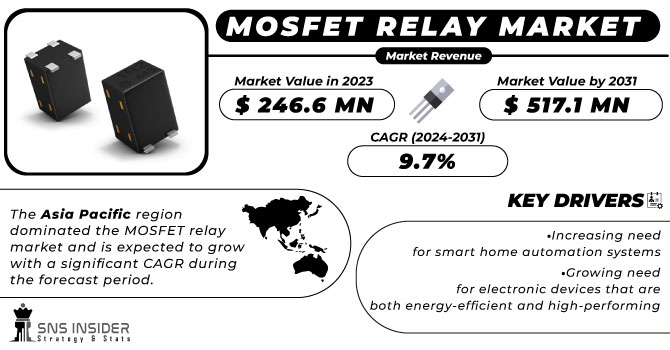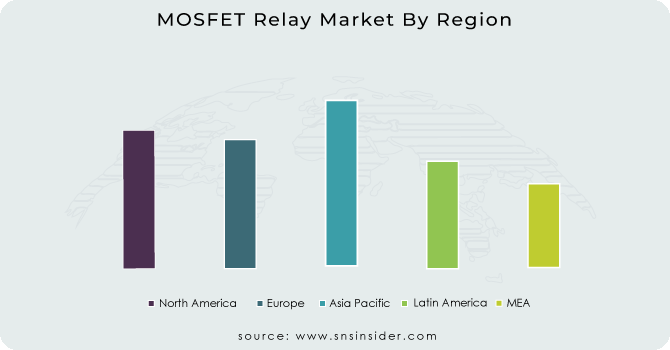MOSFET Relay Market Report Scope & Overview:
The MOSFET Relay Market size was valued at USD 246.6 million in 2023 and is expected to grow to USD 517.1 million by 2031 and grow at a CAGR of 9.7 % over the forecast period of 2024-2031.
The MOSFET relay is a type of electronic switch that utilizes a metal-oxide-semiconductor field-effect transistor (MOSFET) to control the flow of current. This device is commonly used in electronic circuits to switch high voltage and high current loads with minimal power consumption and heat dissipation. The MOSFET relay offers several advantages over traditional mechanical relays, including faster switching speeds, longer lifespan, and greater reliability. These relays are commonly used in a variety of applications, including automotive, industrial, and consumer electronics. Additionally, it is immune to contact bounce and arcing, which can cause damage to sensitive electronic components.

Get More Information on MOSFET Relay Market - Request Sample Report
As the demand for more efficient and reliable electronic devices continues to grow, the MOSFET relay market is expected to experience significant growth in the coming years. Overall, the MOSFET relay market plays a crucial role in the electronics industry, providing essential components that enable the development of advanced electronic devices. As technology continues to advance, the demand for MOSFET relays is only expected to increase during the forecast period.
Market Dynamics:
Drivers
-
Increasing need for smart home automation systems
-
Growing need for electronic devices that are both energy-efficient and high-performing
As consumers become more environmentally conscious, there is a growing demand for products that are energy-efficient and high-performing. MOSFET relays are a perfect solution to meet this demand, as they offer low power consumption, high switching speed, and low on-resistance. These features make MOSFET relays an ideal choice for a wide range of applications, from automotive to industrial. As a result, the MOSFET relay market is experiencing significant growth.
Restrain
-
High initial investment is required
-
High cost associated with MOSFET relay as compared to traditional Electromechanical relays
The MOSFET relay market faces a significant challenge due to the high cost associated with these relays when compared to traditional electromechanical relays. This cost disparity serves as a significant constraint for the adoption of MOSFET relays in various industries. Despite their numerous advantages, including faster switching speeds, lower power consumption, and longer lifespan, the high cost of MOSFET relays remains a significant barrier to their widespread use.
Opportunities
-
Increasing adoption of electric vehicles.
Challenges
-
Lack of standardization in MOSFET relay design and manufacturing can lead to compatibility issues
Impact of COVID-19:
The COVID-19 pandemic has disrupted the global supply chain, causing delays in the production and delivery of MOSFET relays. The closure of factories and restrictions on international trade has also led to a shortage of raw materials, further exacerbating supply chain issues. In addition to the supply chain disruptions, the pandemic has also led to a decline in demand for MOSFET relays. The economic slowdown caused by the pandemic has resulted in a decrease in consumer spending, which has affected the demand for electronic devices that use MOSFET relays.
Impact of Russia-Ukraine War:
The ongoing conflict between Russia and Ukraine has disrupted the supply chain of MOSFET relays, causing a shortage of these components in the market. This shortage has led to an increase in the prices of MOSFET relays, making them less affordable for consumers and businesses alike.
Furthermore, the political instability in the region has also affected the demand for MOSFET relays. Many businesses are hesitant to invest in new projects or expand their operations due to the uncertainty caused by the conflict. This has resulted in a decrease in the demand for MOSFET relays. More detailed insights are comprised in the final report.
Impact of Recession:
The economic downturn has resulted in a decrease in demand for MOSFET relays. As companies have cut back on spending and reduced production, the demand for MOSFET relays has decreased. This has led to a decrease in sales and revenue for manufacturers in the industry. Additionally, the recession has caused a shift in consumer behavior, with many individuals opting for cheaper alternatives to MOSFET relays. More detailed insights are comprised in the final report.
Key Market Segmentation
By Voltage
-
Below 200 V
-
200 V-500 V
-
500 V-1 kV
-
Above 1 kV
By Application
-
Industrial
-
Medical
-
Automotive
-
Test and Measurements
-
Renewables
-
Household Appliances
-
Charging Stations
-
Mining
-
Others
Regional Analysis:
The Asia Pacific region dominated the MOSFET relay market and is expected to grow with a significant CAGR during the forecast period. This growth is attributed to the presence of a large and rapidly growing electronics industry. This has created a high demand for MOSFET relays, which are essential components in electronic devices. The region's strong manufacturing capabilities and skilled workforce have enabled it to meet this demand and produce high-quality MOSFET relays at a competitive price. Moreover, the Asia Pacific region has a favorable regulatory environment that supports the growth of the MOSFET relay market. Governments in the region have implemented policies that encourage the development of the electronics industry, including the MOSFET relay market. This has created a conducive environment for businesses to thrive and innovate.
Asia Pacific region has a strong network of suppliers and distributors, which has facilitated the growth of the MOSFET relay market. This network has enabled businesses to access the resources they need to produce and distribute MOSFET relays efficiently.

Need any customization research on MOSFET-Relay-Market- Enquiry Now
REGIONAL COVERAGE:
-
North America
-
USA
-
Canada
-
Mexico
-
-
Europe
-
Germany
-
UK
-
France
-
Italy
-
Spain
-
The Netherlands
-
Rest of Europe
-
-
Asia-Pacific
-
Japan
-
south Korea
-
China
-
India
-
Australia
-
Rest of Asia-Pacific
-
-
The Middle East & Africa
-
Israel
-
UAE
-
South Africa
-
Rest of the Middle East & Africa
-
-
Latin America
-
Brazil
-
Argentina
-
Rest of Latin America
-
Key Players
The major players are Broadcom, Relpol, Wago, Schneider Electric, Omron Corporation, Standex Electronics Inc, TE Connectivity, Toshiba, Celduc, Chordn Electric, Toward Relays, and other players

Recent Development:
In January 2023, OMRON Electronic Components Europe announced the expansion of its already extensive range of MOSFET relays with the introduction of two new devices namely OMRON G3VM-401 and G3VM-601 that are designed to offer high dielectric strength and operate at high temperatures, making them ideal for use in electric meters and industrial control applications. Additionally, the new G3VM-41UR is a highly responsive device that boasts low on-resistance and output capacitance, all packaged in an ultra-compact VSON format. This device is specifically targeted toward test and measurement applications, particularly ATE.
| Report Attributes | Details |
| Market Size in 2023 | US$ 246.6 Mn |
| Market Size by 2031 | US$ 517.1 Mn |
| CAGR | CAGR of 9.7% From 2023 to 2030 |
| Base Year | 2022 |
| Forecast Period | 2024-2031 |
| Historical Data | 2020-2022 |
| Report Scope & Coverage | Market Size, Segments Analysis, Competitive Landscape, Regional Analysis, DROC & SWOT Analysis, Forecast Outlook |
| Key Segments | • By Voltage (Below 200 V, 200 V-500 V, 500 V-1 kV, Above 1 kV) • By Application (Industrial, Medical, Automotive, Test and Measurements, Renewables, Household Appliances, Charging Stations, Mining, and Others) |
| Regional Analysis/Coverage | North America (USA, Canada, Mexico), Europe (Germany, UK, France, Italy, Spain, Netherlands, Rest of Europe), Asia-Pacific (Japan, South Korea, China, India, Australia, Rest of Asia-Pacific), The Middle East & Africa (Israel, UAE, South Africa, Rest of Middle East & Africa), Latin America (Brazil, Argentina, Rest of Latin America) |
| Company Profiles | Broadcom, Relpol, Wago, Schneider Electric, Omron Corporation, Standex Electronics Inc, TE Connectivity, Toshiba, Celduc, Chordn Electric, Toward Relays |
| Key Drivers | • Increasing need for smart home automation systems • Growing need for electronic devices that are both energy-efficient and high-performing |
| Market Opportunities | • Increasing adoption of electric vehicles. |

